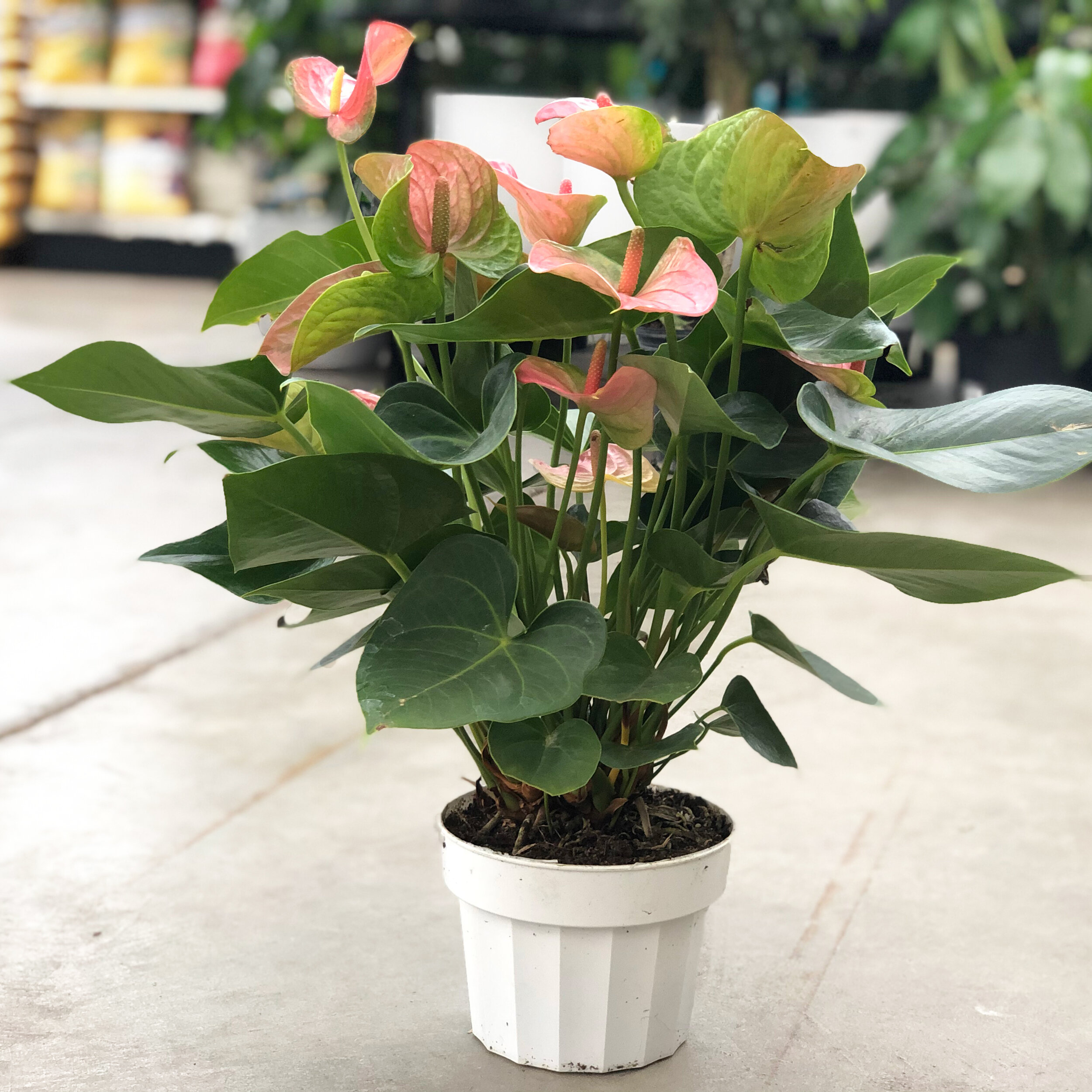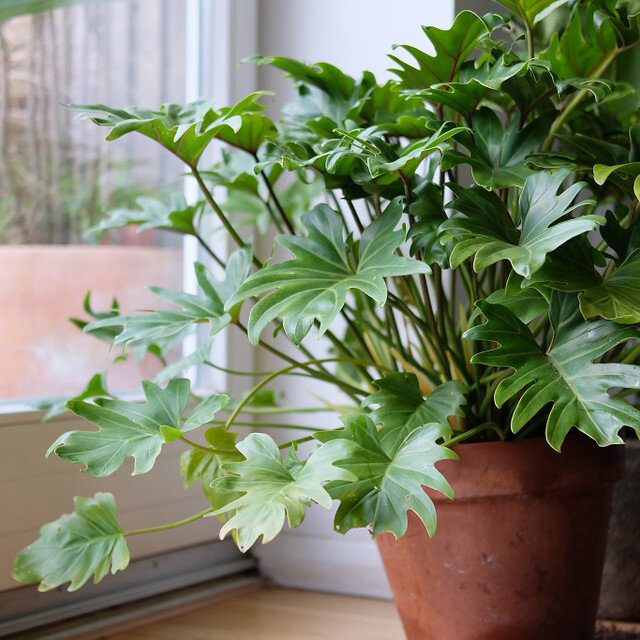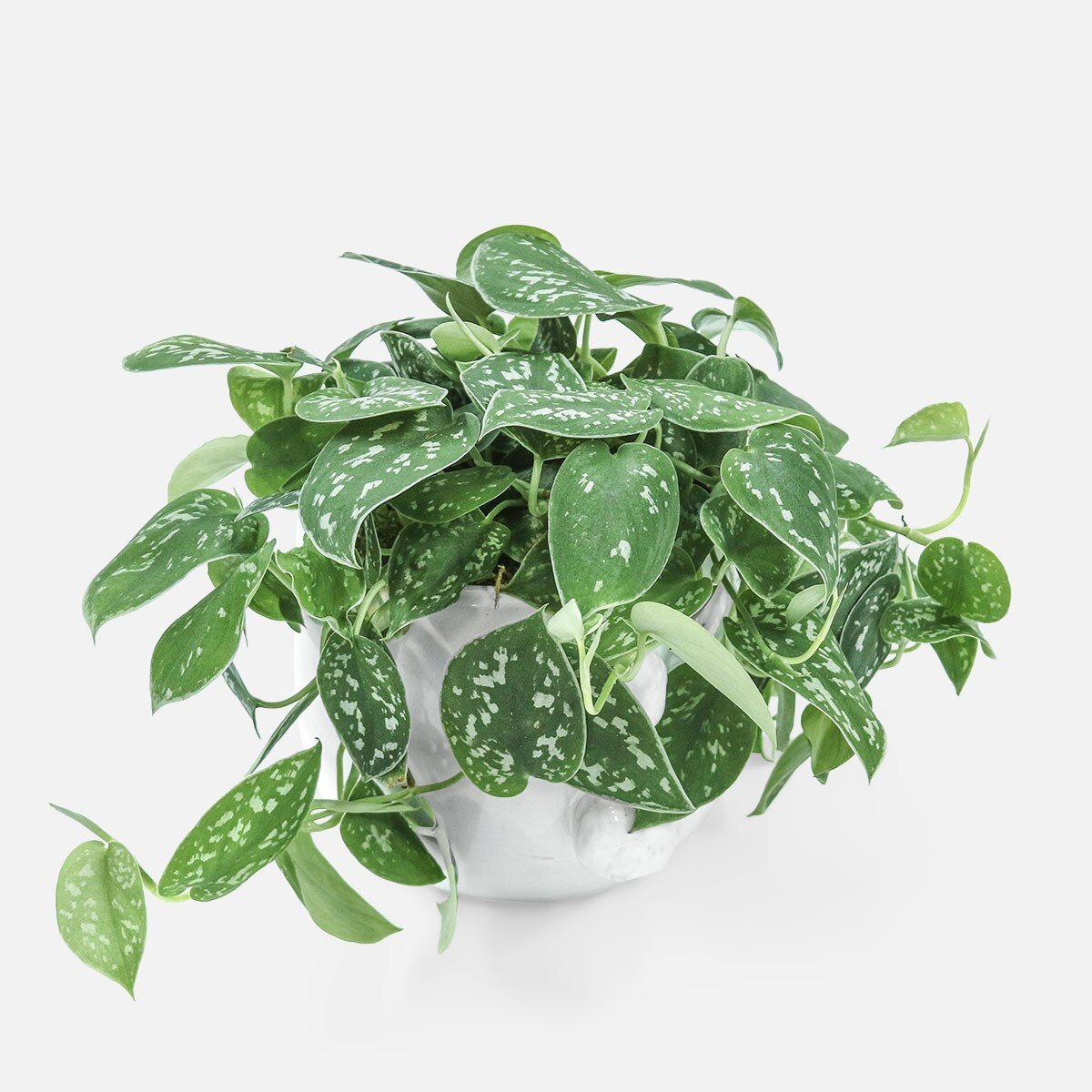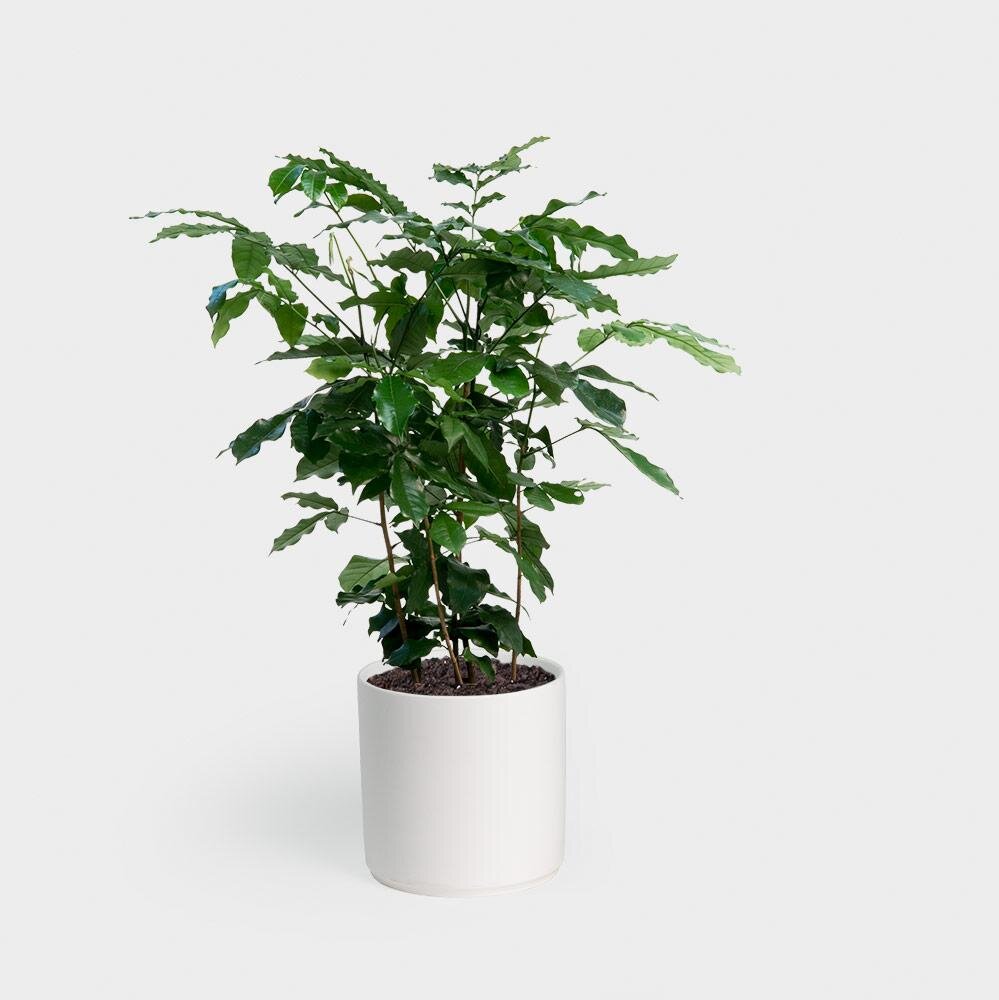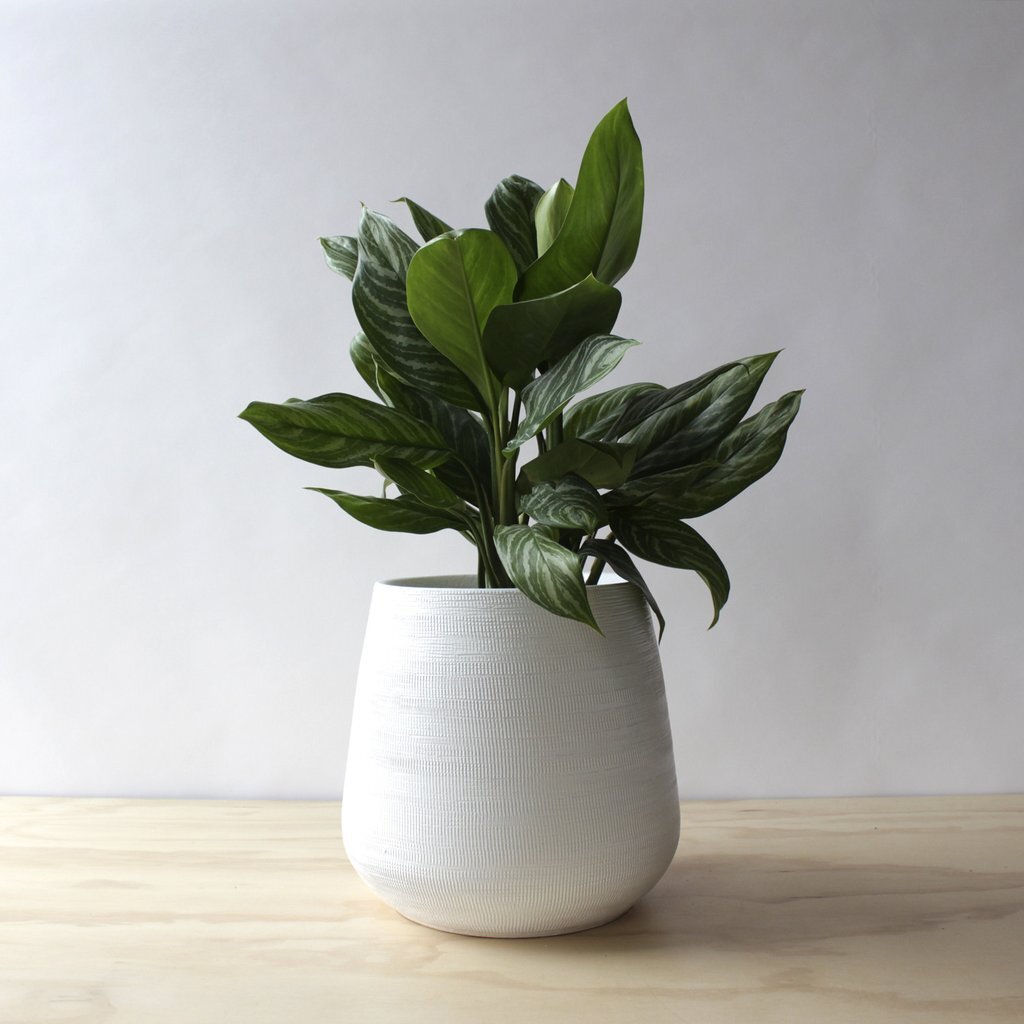Have you ever wondered which indoor plants the people who work with plants every day love the most? We asked some of our employees to share their favorite houseplants and why they like them. The list is varied in terms of aesthetics and size, but there is one factor that made the list over and over: we like easy-care plants, just like you!
Check out our favorites below. We think you might find your new favorite houseplant on this list. And scroll to the bottom for a few quick tips on caring for houseplants in general.
Brandi’s Favorite: Snake Plant
Brandi finds it hard to choose just one favorite houseplant. She loves pothos for its leafy trailing stems, mistletoe cactus for its uniqueness, and snake plant for its dramatic foliage and indestructible nature. This plant withstands everything: drafts, dry air, all light conditions, and neglect. Water your snake plant moderately from spring through fall, letting it dry out mostly between waterings, and very sparingly (once every 1-2 months!) in winter.
Kate’s Favorite: Asparagus Fern
Kate grew up with an asparagus fern and loves the lacy, delicate leaves. This houseplant is not actually a fern nor is it related to asparagus; it’s a part of the lily family but has fern-like foliage. It thrives in part shade, tolerates low light, and likes to stay evenly moist (not sopping wet!) so make a regular watering schedule. This fern also appreciates a little extra humidity. With just a little consistent care, you will be rewarded with beautifully arching, spring-green fronds.
Erich’s Favorite: Anthurium
Erich adores this houseplant for the bright color it brings into his home. Anthurium, in bright indirect light, will bloom almost endlessly! The long-lasting blooms sit atop glossy, heart-shaped leaves and range in color from deep burgundy to bright red to the pale pink shown above. Anthuriums make excellent foliage plants In lower light conditions but may not bloom. Let the soil dry out to 1”-2” before watering again and remember, as tropical plants, they love a little extra humidity.
Miranda’s Favorite: Xanadu Philodendron
Miranda loves philodendrons and this one is nice and compact, perfect for smaller spaces. An easy plant to care for, it prefers bright or medium, indirect light and likes to dry out about halfway before being watered again. If the leaves become pale and bleached in appearance, it may be getting to much light. Fertilize this plant monthly in the spring and fall, and every two weeks in the summer.
Denise’s Favorite: Jade Plant
Jade plants are simple to grow, long-lived, and even considered to be symbols of good luck! Denise likes this plant not only because she can neglect it once in a while, but also because it is fun and easy to propagate. Just place one of its leaves into cactus & succulent potting mix and it will eventually grow roots and baby plantlets. Jade is a succulent that thrives in full sun to bright light. Water well and then let dry out mostly between waterings. Water it less often in the winter (about once a month should be enough).
Chloe’s Favorite: Satin Pothos (Scindapsus pictus ‘Argyraeus’)
Chloe picks this lovely, low-light plant because it’s perfect for anyone who lacks direct sunlight in their home or office. Satin pothos is easy to care for and has an attractive trailing habit with satiny variegated leaves. It prefers bright to medium indirect light and can tolerate low light levels. Let the soil dry out to about 1/4” before watering again. If the leaves start to look floppy, it’s definitely time to water. Fertilize every two weeks from spring to late autumn and monthly in the winter.
Aimée’s Favorite: Natal Mahogany
I’m in love with my natal mahogany, Myrna, for so many reasons: She has lush, tropical foliage that is a glossy deep green; her new leaves come out gently fringed like eyelashes; she grows quickly (Myrna is over 8’ tall) but can be easily pruned to keep her bushy and more compact. If you are looking for a statement plant, this may be it. Natal mahoganies like medium to low, indirect light and plenty of water (let only the surface of the soil dry out before watering again).
Alli’s Favorite: Neanthe Bella Palm
Also called a parlor palm, Alli loves the lush, tropical foliage of this houseplant. This palm is a slow-growing, petite palm that can work in smaller spaces. It was a favorite of the Victorians, who placed it prominently in their parlors, hence the name. It’s also on NASA’s list of top plants that clean the air. It is an easy-care plant that thrives in medium to bright, indirect light and can tolerate low light. Let it dry out to about 1” before watering again.
Cindy’s Favorite: Aglaonema
With so many colors and leaf variations to choose from, the Aglaonema genus has a houseplant for every style. Cindy loves that some have striking bright red or pink variegation while others have silvery patterns on their long, oval leaves. Another bonus? It’s also on NASA’s list. Most varieties prefer medium to low light and regular watering, allowing the top 1”-2” of the soil to dry out before watering again.
A Few Tips on Caring for Your Houseplants
Light:
Bright, indirect light means to keep your plants out of direct light. Many houseplants like bright light but their leaves can burn in the direct sun, especially in the afternoon.
If your houseplant tolerates low light it will not decline in low-light conditions. It may be happier in brighter light, but it should be okay with less-than-ideal light conditions. Important! This does not mean no light. There are no houseplants that will survive a complete lack of light.
When judging whether your light conditions are acceptable for a particular plant, look for variations in growth such as spindly, leggy stems (the plant may need more light and is stretching to search for it), bleached leaves or scorch marks on the leaves (the plant may be in too much light, especially direct sunlight).
Water:
It is preferable to use a pot with drainage holes. Very few houseplants like sitting in soggy soil.
Water your plants slowly and deeply. You want to moisten as much of the soil as possible. Make sure to remove any standing water that accumulates in a saucer or cachepot.
Plants prefer a deep watering less often rather than a sprinkle more often. Remember, you are trying to get the water to soak down all the way to the roots, not just the surface of the soil.
Transplanting:
A few indications that your plant would like to be transplanted: the roots are growing out of the bottom of the pot; water is immediately running out of the drainage holes or dries out very quickly; the plant is top-heavy and falls over easily.
Always use potting soil that is formulated for houseplants. Cacti and succulents appreciate a soil made just for them that is lighter and drains easily.
It is best to transplant your houseplants in the spring and summer when they are actively growing.
Learn more about caring for your houseplants and the 7 health benefits of indoor plants.




